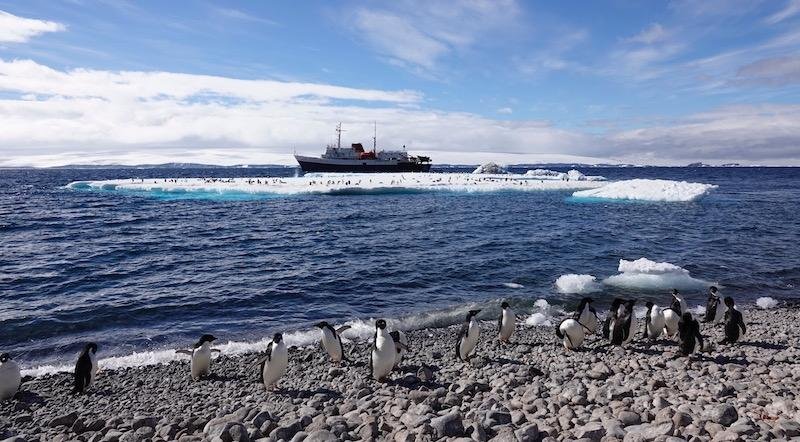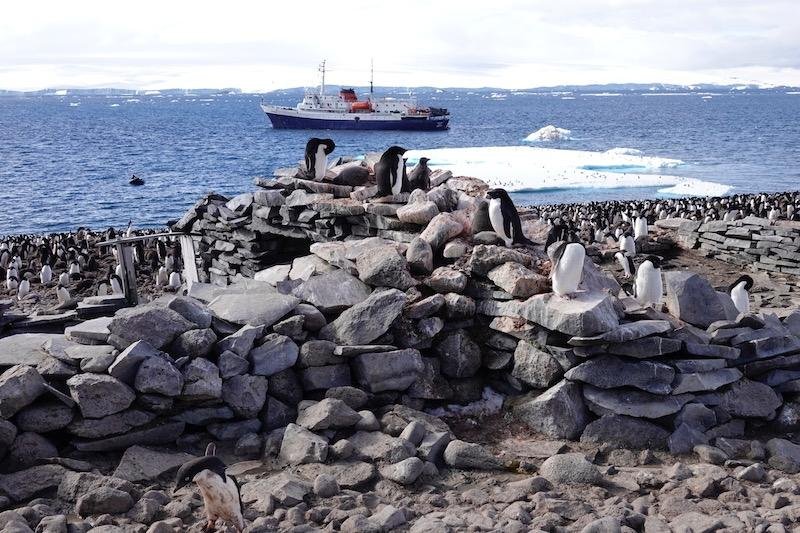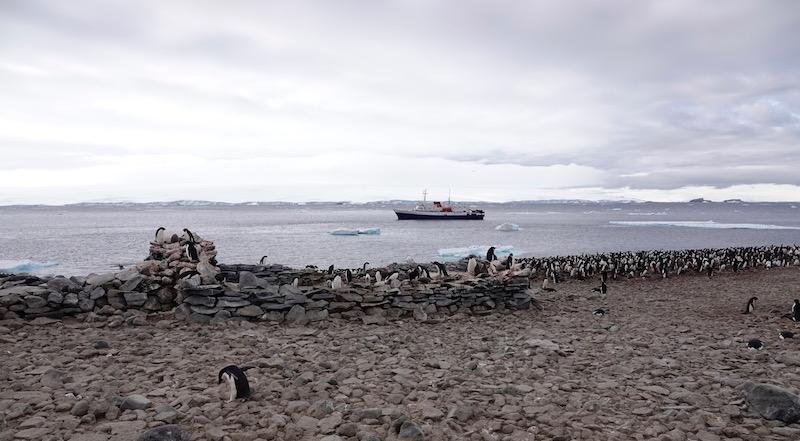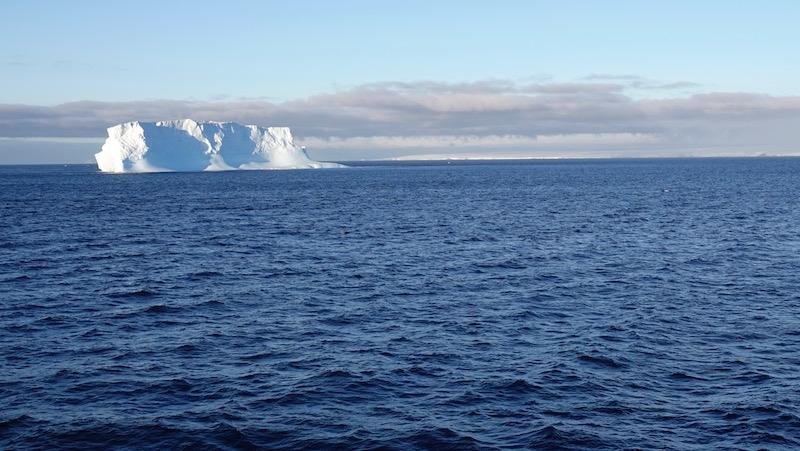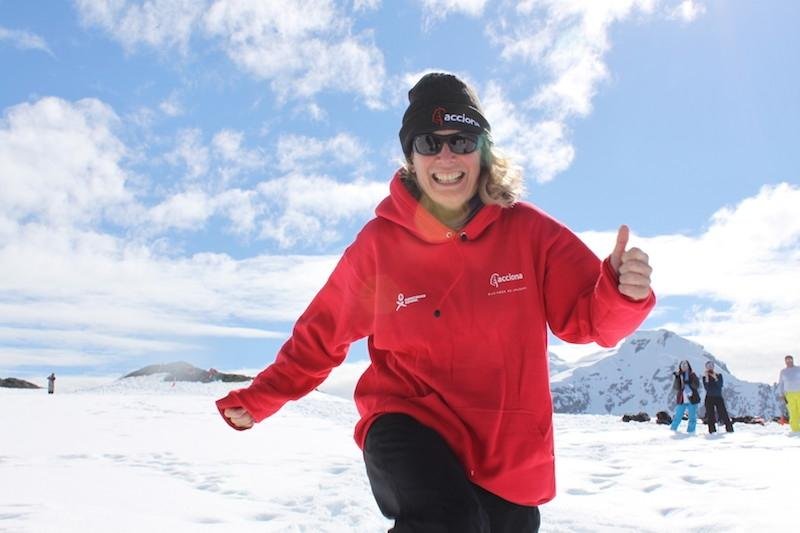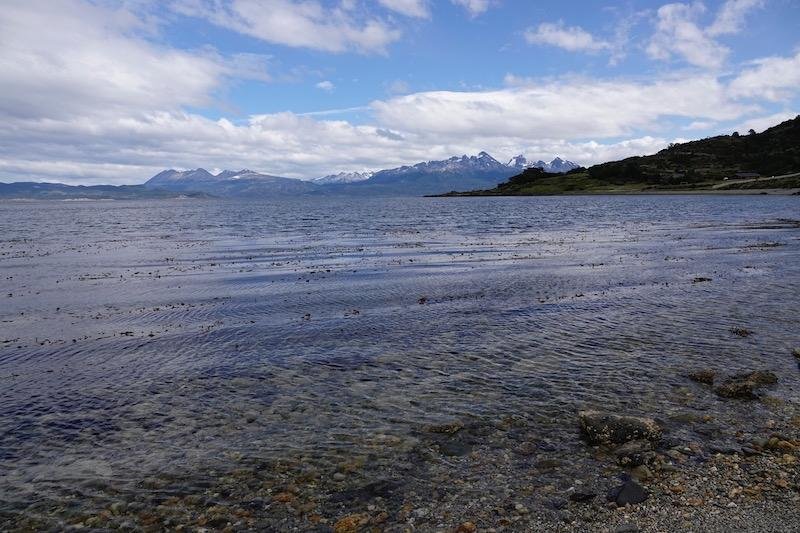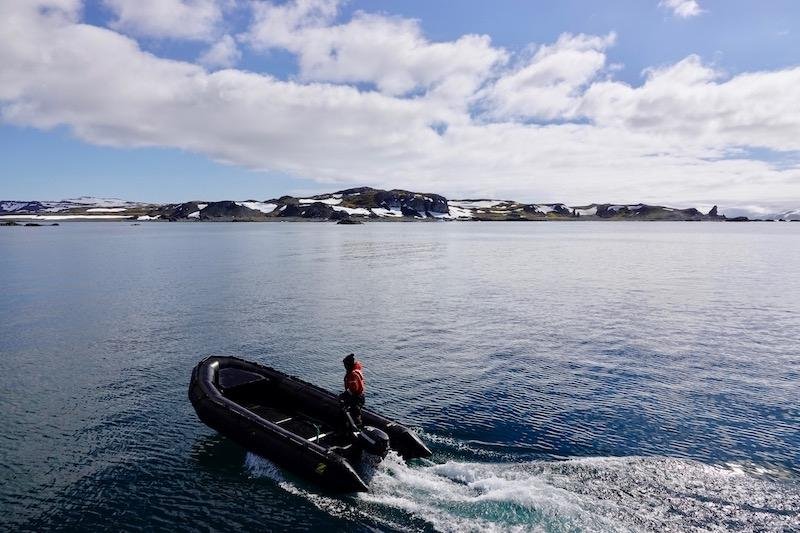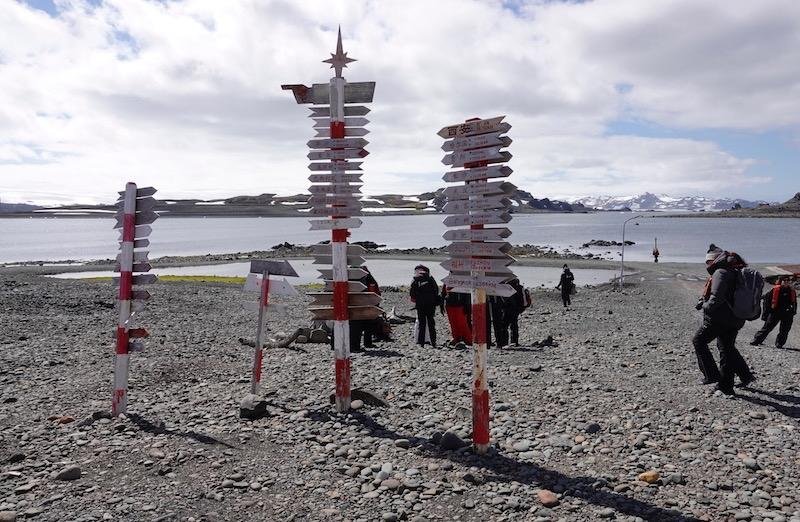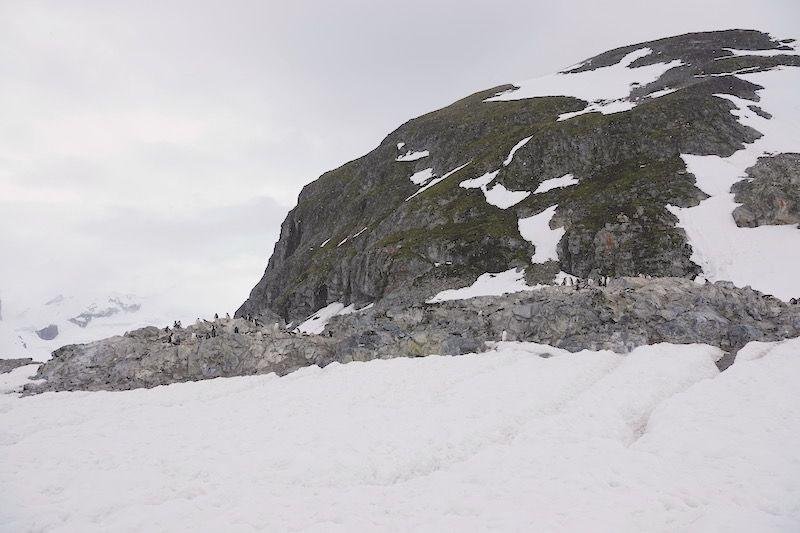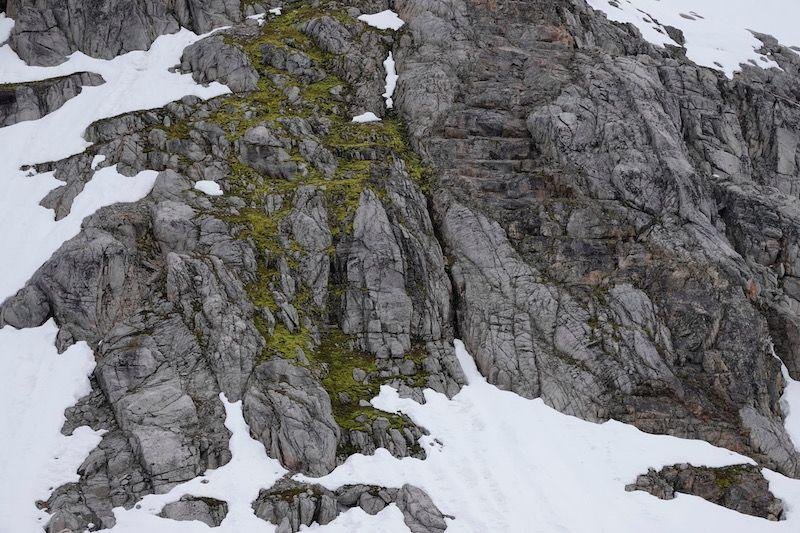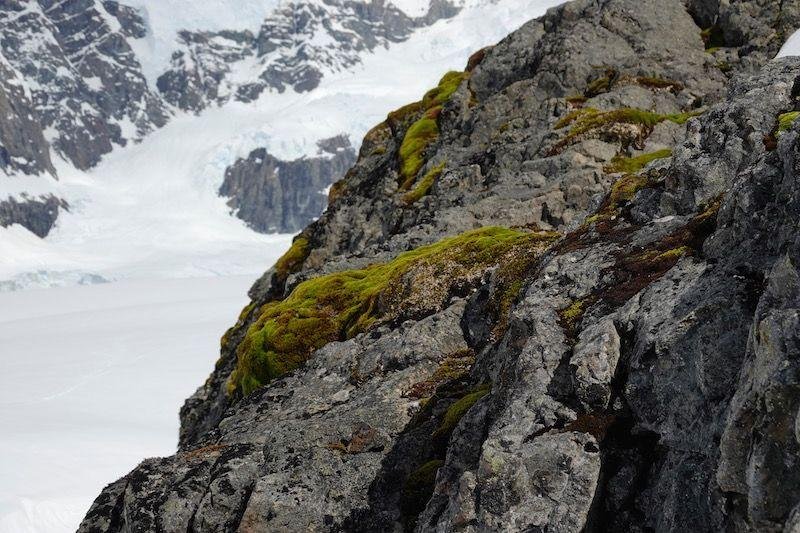
Sharon Robinson
Senior Professor at University of Wollongong
Homeward Bound 3 - Paulet Island
After Great Wall Station we get back on the ship and head off through the Antarctic Sound on the Eastern side of the peninsula. Lots of spectacular tabular icebergs and humpback whales breaching, showing off their tails, and flipper slapping make for a glorious evening’s sailing.
Paulet Island is our next landing spot (4thJan). This island is home to a massive Adelie penguin rookery (100,000 breeding pairs) as well as skuas, kelp gulls, Antarctic sheathbills and cormorants.
The Adelie’s have fluffy brown chicks and so the challenge was to walk along the beach keeping enough distance from the penguins and other nesting birds to reduce our impact. While the younger Adelie penguins were quite curious about us, the nesting birds are understandably wary of visitors especially with so many predatory skuas on the hunt for food. Paulet island also has the remains of a hut built last century by shipwrecked sailors from the Nordenskiöld ship the Antarctic. Today the hut walls are high-rise nesting sites for Adelie penguins.
There is also a massive lake in the middle of the island which is green with algal blooms from all the penguin guano. Even in the cold, the smell from such a large colony is pretty overwhelming.
Despite there being so many Adelie penguins on Paulet, this species is one of the losers from climate change. Adelie penguins are reliant on sea ice and cooler water to provide food and so are losing out to the more generalist feeders, chinstrap and Gentoo penguins, which are expanding southwards especially on the western side of the Antarctic peninsula.
The Ushuaia crew are Argentinian and Chilean. Our female voyage leader Monica Schillat, is an historian and has many tales to tell of her years of working on Antarctic vessels. Kata, one of the expedition guides, has just finished her PhD researching orcas which means we have lots of expertise to draw on. Leandro and Juan like plants too so I am in good company. Because the weather is so calm we get to take many iceberg cruises and see lots of humpback whales and orcas. One night I am sure I can hear the humpbacks calling and in the zodiac boats we get close enough to smell their fish-oily breath. We often see weddell and crabeater seals hauled out on ice flows or swimming along beaches.
Homeward Bound - A leadership voyage of Discovery
Sharon has just returned from 19 days aboard the MV Ushuaiaas part of the Homeward Bound HB3 voyage. Homeward Bound is a ground-breaking leadership initiative, set against the backdrop of Antarctica, which aims to heighten the influence and impact of women in making decisions that shape our planet.
I was invited to join the Homeward Bound Leadership Faculty for the third voyage (HB3) which departed Ushuaia in Argentina on 31st Dec 2018. My role was to deliver the On-Board Science Stream content with Dr Katherine Duncan (University of Strathclyde). In 2019 we were extremely lucky to have the inspiring and stubbornly optimistic Christiana Figueras join the Leadership Faculty. This is my blog.
Days 1-6
We left on New Year’s Eve 2018, after two days of travelling and then three days of on shore program delivered in Ushuaia. By the time we found our cabins and unpacked, securing all our belongings to ensure they survived the Drake Passage, we were ready for a good rest. So many of us spent a lot of the Drake crossing catching up on sleep.
We arrived in the South Shetland islands on the 3rd Jan 2019.
Our first visit ashore was to King George Island which is home to many Antarctic stations. I have visited this island twice before with colleagues, Dr Angelica Casanova-Katny (University of Temuco) and Professor Gustavo Zuniga (USACH), staying at the Chilean Summer Scientific Station, Escudero. I am excited to see Ardley Island from the ship as we sail by. This Antarctic Specially Protected Area, has some of the best lichens I have ever seen, but I am surprised to see there is very little snow on the island. However, this is good news for Dr Melinda Waterman who will be arriving at Escudero in the next few days. Less snow means it will be easier for her to make the measurements of moss microclimate that we need.
Meanwhile, the HB3 team visit the Chinese Great Wall Station where were saw the museum which shows what life was like for Antarctic expeditioners in the 1980s and walked around the station. While visits to stations by tourist ships are limited, interstation visits for researchers are quite common. In 2015, whilst at Escudero, I was lucky enough to be invited to Sunday afternoon tea at Great Wall Station and we saw the new Science Laboratory and station library.
More unusually, in 2013, Angelica and I attended the Metallica concert at Carlini Base. Not the sort of thing you expect to be invited to whilst researching mosses in Antarctica! King George Island was the furthest south I had been on this side of Antarctica so all the other locations were new experiences for me.
Antarctica’s ‘moss forests’ are drying and dying
The lush moss beds that grow near East Antarctica’s coast are among the only plants that can withstand life on the frozen continent. But our new research shows that these slow-growing plants are changing at a far faster rate than anticipated.
Read more in the Conversation
Plus here is a link to our latest youtube video
Sharon Robinson, Melinda Waterman & Andrew Netherwood (2017) East Antarctic mosses reveal a windier, drier climate
The paper is available here if you want to read it. This email address is being protected from spambots. You need JavaScript enabled to view it. if you want a copy.
Robinson SA, King D, Bramley-Alves J, Waterman MJ, Ashcroft MB, Wasley J,Turnbull JD,Miller RE,Ryan-Colton E, Benny T, Mullany K, Clarke, LJ, Barry, L, HuaQ. (2018) Rapid change in East Antarctic terrestrial vegetation in response to regional drying. Nature Climate Change8, 879-884, DOI: 10.1038/s41558-018-0280-0
Drones help scientists check the health of Antarctic mosses, revealing climate change clues
Drones are helping scientists check the health of Antarctic mosses, revealing clues on the pace of climate change.
Read more in the Conversation
Plus here is the Youtube video
and if you want to read the paper
Malenovský Z, Lucieer A King DK, Turnbull JD & Robinson SA (2017) Unmanned aircraft system advances health mapping of fragile polar vegetation. Methods in Ecology and Evolution 8 1842-1857
Witnessing changes in Antarctica’s ancient forests
Professor Sharon Robinson has just returned from 19 days aboard the MV Ushuaia as part of the Homeward Bound Leadership Faculty 2019. She led the On Board Science Stream leader with Dr Katherine Duncan.
Antarctica seems like a long way from anywhere but climate change is affecting the tiny plants and animals that make their home there. Along the Antarctic Peninsula region, that Homeward Bound 3 is visiting, the climate is becoming much warmer and wetter which means that plants can colonise new ice-free areas and grow faster.

On the other side of the continent it is getting colder and drier and the plants are having a tougher time. My team have shown that some East Antarctic moss beds are drying out and dying.2-4So from pole to pole, and all around Antarctica, these tiny plants are recording how we are changing our planet as they grow. My team’s work shows that although these plants are tiny (a few centimeters tall), they can be hundreds of years old. They are the old growth forests of Antarctica, home to tiny microscopic animals, like water bears or moss piglets (tardigrades) springtails and nematode worms, as well as fungi and microbes. We know the plants are hundreds of years oldbecause as they grow, they lay down a signal of the carbon dioxide in the air and so record changes in the composition of carbon dioxide. From coal burning to radioactivity released from nuclear testing in the 1950s and 1960s (the bomb pulse) they are recording the Anthropocene from the bottom of the globe. That means they are sentinels for our past, as well as early warning of possible global futures.
These plants survive freezing winters, emerging from under winter snow for a brief summer of weeks to just a few months. They get their water from ice melt and their nutrients from ancient deposits of penguin poo, as well as more recent bird droppings.
They grow all around the Antarctic coast, and it is exciting to think that we may be the first people to see some of these plants as they take over newly exposed land on the peninsula.
On 13thJanuary, we saw a lot of moss growing near the Admirante Brown (Argentinian) Station. Based on their past visits, our guides on the Ushuaia were able to show us how fast the ice is retreating behind the station and we can see the moss that is colonising these newly exposed rocks. We saw many species of bright green moss on this one landing.
The day was so warm, we could see tiny animals, small as a pin head, running around. These invertebrates live in the tiny moss forests and on warm days roam around the nearby rocks looking for food. I was excited to see my first Antarctic midge (Belgica antarctica), the wingless fly that is found on the Peninsula.
But there is also a sobering message of climate change in action. Seeing first hand, how quickly the glaciers are retreating and the area is changing, makes the Homeward Bound goal of building a sustainable global future even more important.
References
- Waterman M, Turnbull J and Robinson, S (2018) Antarctica’s ‘moss forests’ are drying and dying https://theconversation.com/antarcticas-moss-forests-are-drying-and-dying-103751
- Sharon Robinson, Melinda Waterman & Andrew Netherwood (2017) East Antarctic mosses reveal a windier, drier climate https://youtu.be/LF4p3ng0HRQ
- Robinson SA, King D, Bramley-Alves J, Waterman MJ, Ashcroft MB, Wasley J,Turnbull JD,Miller RE,Ryan-Colton E, Benny T,Mullany K,Clarke, LJ, Barry, L, HuaQ. (2018) Rapid change in East Antarctic terrestrial vegetation in response to regional drying.Nature Climate Change 8, 879-884, DOI: 10.1038/s41558-018-0280-0
Life of extremes. Women of Impact
A feature about my research on the UOW Women of Impact Series. Includes a brief overview and a video.
TEDx Talk
Antarctic terrestrial communities in a time of change
Click on the title to go to the item page where you wll find the video player
A Part of GLOBALCHALLENGES.UOW.EDU.AU
Global Change Biology Ozone Paper 2014 Presentation
This is a short online lecture-style presentation that gives an overview of this paper.
Online Lecture - Photosynthesis and Light
This is an online lecture for first year biology undergraduates at the University of Wollongong. It was originally a Powerpoint Lecture that was converted to the online format using Articulate Presenter which is a plugin for PowerPoint.

